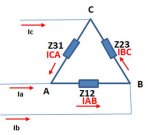For the Phase Current, I showed a 30 Degree Phase Shift?
Since
IL= Ip√3∠-30, so IaA/√3∠-30 = 40.41∠-10
Also I thought in a delta configuration the line voltage equals the phase voltages.
In your first solution, you used a phase voltage and need to use √3
∠-30 instead of just √3 as the multiplier.
In the complex power equation, you can't mix line currents with phase voltages without a conversion factor.
The phase current is through the load element. The phase voltage is across the load element. The line current is in the line to the left. The line voltage is line to neutral but the neutral point is not shown in the circuit diagram.
In the circuit you have, the phase voltage is across the load. The line current coming in is a composite of the two phase currents leaving the corner of the delta.
In a wye winding, phase current through the winding equals the line current leaving the transformer, if we call the winding a phase.
In a delta winding, phase current through the winding does not equal line current leaving the transformer because the line current is the combination of two phase currents.
We normally consider phase voltage to mean line to line and line voltage to mean line to neutral unless it is defined differently during the givens of the problem.




